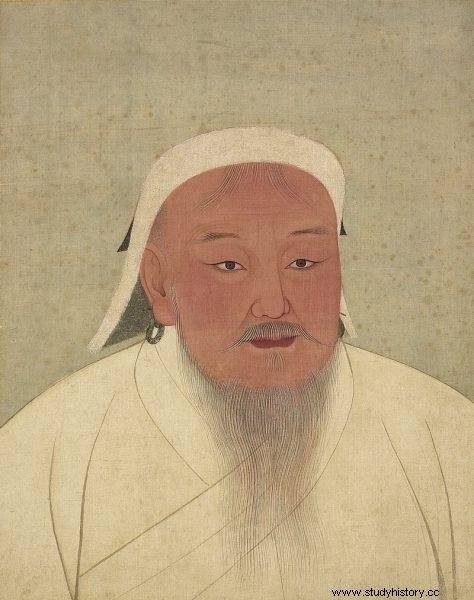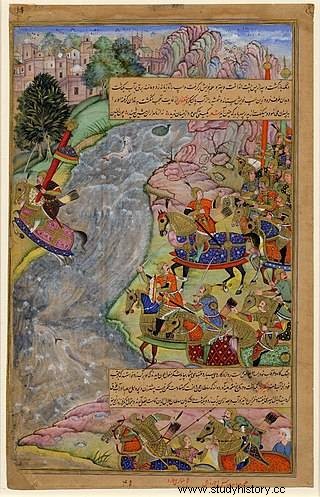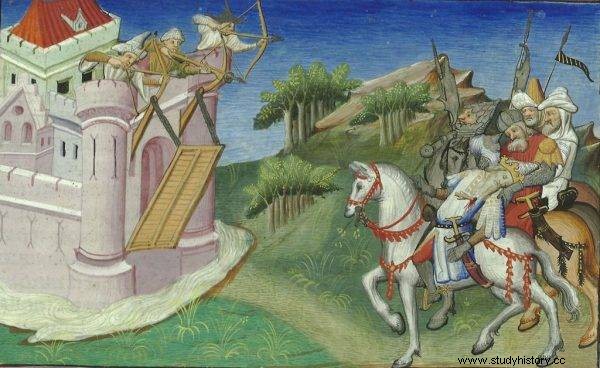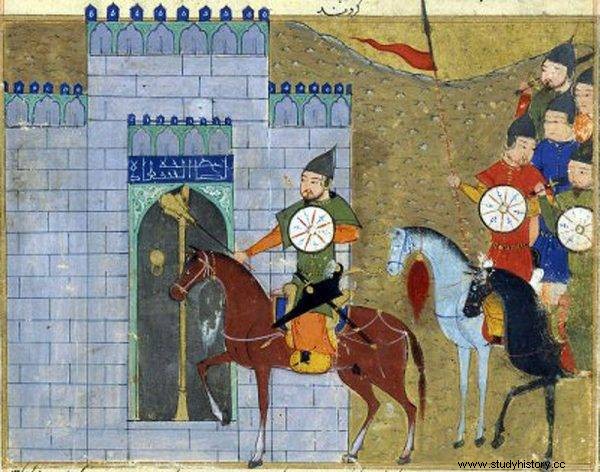Which of the great historical rulers killed the most people? According to many, no one in this aspect could compare with the famous Genghis Khan. Is it really?
The history of the world is full of distortions and understatements. Sometimes things considered facts have little to do with reality. On the other hand, events that seem too eerie to be true turn out to be the most real. In the "Truth or Myth" series, we will attempt to debunk or confirm both these less and more serious historical myths. The story is not as obvious as it seems!
Heaven sent
At the time of its greatest power, the Mongol empire stretched from the Japanese sea to Russia. This enormous political creation could not have existed without the military genius of Genghis Khan. However, a grim legend is associated with his person. The Mongol leader is often considered the greatest criminal in the history of mankind and the legend of the cruelty of his army lives on even today. But are the rumors of Genghis Khan's bestiality true?

Genghis Khan is often considered the greatest criminal in the history of mankind
According to a legend that circulated among the nomadic tribes of Northeast Asia in the 12th century, one day a hero, a messenger from heaven, would appear, who would unite all the peoples there and conquer the world. This prophecy was fulfilled in 1162. Yeshuga-bahatur, the head of the Mongolian Kijot-Bordżigi family, found out then that his wife, Olun, had given him a son. Due to the fact that Jesuga has just returned from a victorious war expedition , he named his newborn descendant Temujin after one of the Tatar chiefs .
After many years and countless battles with other tribes, Temujin became the ruler of all Mongol lands. In 1206, at the Seym called by the Mongols the kurultai he was proclaimed a khan (the khan [king] of all khans) and he himself took the name Genghis Khan . The Mongol ruler then began conquering the surrounding states:the Chinese Jin Empire, the Kara Kitayan Khanate, the Khorez, Rus and Tangutu states. In addition to his extraordinary military talent, he also had a very good political sense, he was a great organizer and strategist. Contrary to what the legend has it, to his opponents was not an exile from heaven, but from hell. He was a ruthless leader who condemned hundreds of thousands to death with a single command. What really guided Genghis Khan when he slaughtered entire cities to the trunk?
The theory of terror
In a country as vast as that created by Genghis Khan, it was necessary to rule with an iron fist. An empire composed of a great number of nations, tribes and nations could only function efficiently when all centrifugal forces were nipped in the bud. On the one hand, there was a great religious tolerance in the Mongolian state on the other hand, there was an extremely strict and rigorous legal system called Jasak-Jasa . Many crimes were punishable by death. A similar regime prevailed in the Mongolian army.

The fear sown in the hearts of the tribes and nations living in the Mongol state inhibited their inclination to rebellion.
Genghis Khan knew that by introducing strict laws and tough rules, his empire would be immune to decay from within. The fear sown in the hearts of the tribes and nations living in the Mongolian state inhibited their efforts to rebel. Temujin's methods were even worse with regard to the population of the countries that were the target of his conquests. During a reign of more than twenty years, terror was an essential element of Genghis Khan's external policy. The fear of his army was supposed to facilitate the conquest of neighboring countries, and the very thought of confronting fearless Mongolian warriors meant that the enemy's morale was broken before the start of military operations.
When there was a battle or siege, Genghis Khan was not so much ruthless as extremely pragmatic. He ordered the remnants of soldiers fleeing the battlefield to be chased to the very end and killed to reduce the enemy's living strength as much as possible. The population in the captured and destroyed cities was not murdered with hatred, but to increase the fear of the Mongol army. One can even risk a statement that one of the greatest murderers in the history of the world was not a ruler fond of looking at human harm . Chan was known to rarely get carried away , and all the activities he undertook were strictly pragmatic and served overriding strategic goals. This cool calculation, however, led to an unimaginable number of victims of the Mongolian war machine.
Kill them all
Estimates of historians and statisticians show that during the six years of the deadliest war conflict in history, i.e. World War II, died from 50 to even 80 million people . This number is frightening, but in view of the rapid development of military technology and weapons, which took place at the beginning of the 20th century, it was possible. What is shocking about the balance of casualties of Genghis Khan's army is the fact that as early as in the 13th century, using rather primitive weapons, the Mongols were able to murder up to 40 million people . Many researchers are willing to lower these bills today, but even if the number of casualties of the Mongolian army was divided in half, the result would still be alarming.

Genghis Khan had the bloodiest harvest during the conquest of China
The bloodiest harvest was to be harvested by Genghis Khan during the conquest of China. Demographers studying the history of the Middle Kingdom report that during the battles with the Mongols, the population of both then empires (Jin and Sung) shrank by a shocking 30-35 million. (Here, however, it should be remembered that the conquest of the Sung Empire took place after the death of Genghis Khan). The capture of Beijing in 1215 was a symbol of this genocide. The Mongols besieged the imperial capital, but decided not to storm. They blocked the city and starved its inhabitants to death. One of the envoys from the Kara Kitai Khanate who came to Beijing shortly afterwards wrote:" bones the dead were mountains, and the soil was greasy with human fat. ”
The country of this foreign envoy was another target of the Mongolian army. Temujin killed about 1.5 million of its inhabitants . Another several million victims were the aftermath of the struggle to control Khorez (today's Iran and Afghanistan) and Rus. The numbers given above are really hard to believe. Even taking into account the very long, twenty-year period of Genghis Khan's conquests (1206-1227), how is it possible to annihilate tens of millions of human lives using primitive 13th-century weapons?
The art of war
The first factor that led to the exceptionally large number of Mongol casualties is the aforementioned "follow-up" strategy . After defeating the enemy troops, the cavalry mercilessly pursued the survivors fleeing the field. One of the best examples of this type of activity was the disgraceful defeat of the Ruthenians in the Battle of the Kałka River in 1223. Destroyed in a major battle, they were further ruthlessly pursued by the Mongol army. Overall, approximately 70,000 Ruthenians were killed. So when the Mongols won the battles, they were overall victories, with a large number of deaths on the other side.
Another element influencing the above-average balance of casualties in Genghis Khan's army was how the Mongols solved the issue of conquering fortified cities and fortresses. Building siege engines was only part of the science of the new art of war which they had to master. A much more important and effective tactic they developed was forcing prisoners of war to take over besieged cities. Thanks to this, the Mongols did not deplete their main forces.

A much more important tactic of the Mongols was to force prisoners of war to capture besieged cities.
The countryside surrounding the siege was devastated, crops were destroyed, and the people of the region became a resource for the storm. Citizens of the city locked in a siege often had to repel attacks by formations composed of members of their families or former neighbors . Even when they managed to defend themselves against the invasion of the Mongolian chord, the total destruction of crops and all surrounding infrastructure eventually led to famines and further deaths.
Apocalypse Now
When the Mongols entered the captured city, they slaughtered most of its inhabitants . It was not dictated by hatred of the enemy, but purely strategic reasons. The completely destroyed city ceased to be a means of any resistance . The army could rest assured that a revolt would not break out behind its rear and the captured cities would not be recaptured by the enemy's forces. Only the most useful citizens of a given settlement - e.g. craftsmen - could be pardoned and transported deep into the country. Everything else went under the ax.
One of the most famous acts of this type is the slaughter of Nishapur (today's Northeast Iran). In 1221, when the Mongols entered the city, initially promised to spare its inhabitants if they gave them all their wealth. When this happened, Tułuj (Tołuj) - an army general and the youngest son of Genghis Khan - changed his mind, however, and decided to murder the entire population of Nishapur . According to Persian chroniclers, 1.7 million people lost their lives. This mass murder act was to last 4 days. All the inhabitants of the city had their heads cut off and arranged into three separate pyramids:for men, women and children. Then the buildings were completely destroyed and barley was sown on the rubble. In the 20 years of Genghis Khan's conquests, hundreds of cities suffered a similar fate.
However it may sound, for those times the Mongols were quite humane in their crimes. Genghis Khan used death and terror as tools to achieve strategic goals. Thanks to this, the Mongols in a surprising way deviated from the standard practices of their contemporaries. They did not torture or mutilate their victims. Contrary to the then war trends, they also did not organize public displays of the macabre mutilation of captured prisoners. They killed a lot, but also very quickly.
Lord of life and death
Analyzing the period of Mongol conquests led by Genghis Khan, indeed this ruler can be considered one of the greatest criminals in the history of the world. He made terror and death an instrument of politics and murdered millions of innocent lives with cold calculation. Despite the terrifying aura that surrounds him, he cannot be denied his brilliant strategic skills, political sense and organizational talent. For some, Temujin was a bloodthirsty monster, for others a genius who consistently implemented his plan to conquer the whole world.
Genghis Khan was the greatest murderer in history. True
Bibliography:
- Zatorski, Genghis-Khan wars 1194-1242 , Poznań 2015.
- Weatherford, Genghis Khan and the Making of the Modern World , New York 2005.
- White, Atrocities The 100 Deadliest Episodes in Human History , New York 2013.
- McLynn, Genghis Khan his conquests, his empire, his legacy by Genghis Khan , Philadelphia 2015,
